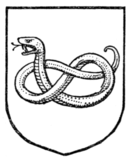A Complete Guide to Heraldry/Chapter 16
CHAPTER XVI
REPTILES
IF armorial zoology is "shaky" in its classification of and dealings with fish, it is most wonderful when its laws and selections are considered under the heading of reptiles. But with the exception of serpents (of various kinds), the remainder must have no more than a passing mention.
The usual heraldic Serpent is most frequently found "nowed," that is, interlaced in a knot (Fig. 483). There is a certain well-understood form for the interlacing which is always officially adhered to, but of late there has manifested itself amongst heraldic artists a desire to break loose to a certain extent from the stereotyped form. A serpent will sometimes be found "erect" and occasionally gliding or "glissant," and sometimes it will be met with in a circle with its tail in its mouth—the ancient symbol of eternity. Its constant appearance in British armory is due to the fact that it is symbolically accepted as the sign of medicine, and many grants of arms made to doctors and physicians introduce in some way either the serpent or the rod of Æsculapius, or a serpent entwined round a staff. A serpent embowed biting its tail occurs in the arms of Falconer, and a serpent on its back in the crest of Backhouse. Save for the matter of position, the serpent of British armory is always drawn in a very naturalistic manner. It is otherwise, however, in Continental armory, where the serpent takes up a position closely allied to that of our dragon. It is even sometimes found winged, and the arms of the family of Visconti, which subsequently came into use as the arms of the Duchy of Milan (Fig. 484), have familiarised us as far as Continental armory is concerned with a form of serpent which is very different from the real animal or from our own heraldic variety. Another instance of a serpent will be found in the arms of the Irish family of Cotter, which are: "Argent, a chevron gules between three serpents proper," and the family of Lanigan O'Keefe bear in one quarter of their shield: "Vert, three lizards in pale or." The family of Cole bear: "Argent, a chevron gules between three scorpions reversed sable," a coat of arms which is sometimes quoted with the chevron and the scorpions both gules or both sable. The family of Preed of Shropshire bear: "Azure, three horse-leeches;" and the family of Whitby bear: "Gules, three snakes coiled or; on a chief of the second, as many pheons sable." A family of Sutton bears: "Or, a newt vert, in chief a lion rampant gules all within a bordure of the last," and Papworth mentions a coat of arms for the name of Ory: "Azure, a chameleon on a shady ground proper, in chief a sun or." Another coat mentioned by Papworth is the arms of Bume: "Gules, a stellion serpent proper," though what the creature may be it is impossible to imagine. Unfortunately, when one comes to examine so many of these curious coats of arms, one finds no evidence that such families existed, or that there is no official authority or record of the arms to which reference can be made. There can be no doubt that they largely consist of misreadings or misinterpretations of both names and charges, and I am sorely afraid this remark is the true explanation of what otherwise would be most strange and interesting curiosities of arms. Sir Walter Scott's little story in "Quentin Durward" of Toison d'Or, who depicted the "cat looking through the dairy window" as the arms of Childebert, and blazoned it "sable a musion passant or, oppressed with a trellis gules, cloué of the second," gives in very truth the real origin of many quaint coats of arms and heraldic terms. Ancient heraldic writers seem to have amused themselves by inventing "appropriate" arms for mythological or historical personages, and I verily believe that when so doing they never intended these arms to stand for more than examples of their own wit. Their credulous successors incorporated these little witticisms in the rolls of arms they collected, and one can only hope that in the distant future the charming drawings of Mr. E. T. Reed which in recent years have appeared in Punch may not be used in like manner.
There are but few instances in English armory in which the Toad or Frog is met with. In fact, the only instance which one can recollect is the coat of arms attributed to a family of Botreaux, who are said to have borne: "Argent, three toads erect sable." I am confident, however, that this coat of arms, if it ever existed, and if it could be traced to its earliest sources, would be found to be really three buckets of water, a canting allusion to the name. Toads of course are the charges on the mythical arms of Pharamond.

Fig. 484.—Arms of the Visconti, Dukes of Milan: Argent, a serpent azure, devouring a child gules. (A wood-carving from the castle of Passau at the turn of the fifteenth century.)
Lizards appear occasionally in heraldry, though more frequently in Irish than English or Scottish coats of arms. A lizard forms part of the crest of Sillifant, and a hand grasping a lizard is the crest of M‘Carthy, and "Azure, three lizards or" the first quarter of the arms of an Irish family of the name of Cotter, who, however, blazon these charges upon their shield as evetts. The family of Enys, who bear: "Argent, three wyverns volant in pale vert," probably derive their arms from some such source.

